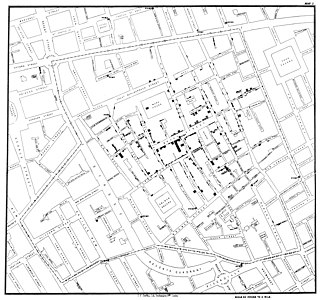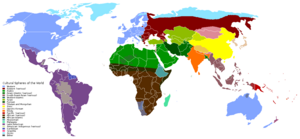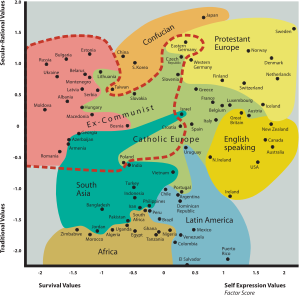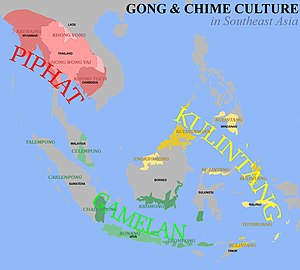
Human geography or anthropogeography is the branch of geography that studies spatial relationships between human communities, cultures, economies, and their interactions with the environment, examples of which is studied in schools are urban sprawl, urban redevelopment etc. It analyzes spatial interdependencies between social interactions and the environment through qualitative and quantitative research methods.

A geographer is a physical scientist, social scientist or humanist whose area of study is geography, the study of Earth's natural environment and human society, including how society and nature interacts. The Greek prefix "geo" means "earth" and the Greek suffix, "graphy," meaning "description," so a geographer is someone who studies the earth. The word "geography" is a Middle French word that is believed to have been first used in 1540.

Economic geography is the subfield of human geography which studies economic activity and factors affecting them. It can also be considered a subfield or method in economics. There are four branches of economic geography. There is, primary sector, Secondary sector, Tertiary sector, & Quaternary sector.

Regional geography is a major branch of geography. It focuses on the interaction of different cultural and natural geofactors in a specific land or landscape, while its counterpart, systematic geography, concentrates on a specific geofactor at the global level.
Feminist geography is a sub-discipline of human geography that applies the theories, methods, and critiques of feminism to the study of the human environment, society, and geographical space. Feminist geography emerged in the 1970s, when members of the women's movement called on academia to include women as both producers and subjects of academic work. Feminist geographers aim to incorporate positions of race, class, ability, and sexuality into the study of geography. The discipline has been subject to several controversies.

Yi-Fu Tuan was a Chinese-born American geographer. He was one of the key figures in human geography and arguably the most important originator of humanistic geography.
Political geography is concerned with the study of both the spatially uneven outcomes of political processes and the ways in which political processes are themselves affected by spatial structures. Conventionally, for the purposes of analysis, political geography adopts a three-scale structure with the study of the state at the centre, the study of international relations above it, and the study of localities below it. The primary concerns of the subdiscipline can be summarized as the inter-relationships between people, state, and territory.
Behavioral geography is an approach to human geography that examines human behavior by separating it into different parts. In addition, behavioral geography is an ideology/approach in human geography that makes use of the methods and assumptions of behaviorism to determine the cognitive processes involved in an individual's perception of or response and reaction to their environment. Behavioral geographers focus on the cognitive processes underlying spatial reasoning, decision making, and behavior.

The quantitative revolution (QR) was a paradigm shift that sought to develop a more rigorous and systematic methodology for the discipline of geography. It came as a response to the inadequacy of regional geography to explain general spatial dynamics. The main claim for the quantitative revolution is that it led to a shift from a descriptive (idiographic) geography to an empirical law-making (nomothetic) geography. The quantitative revolution occurred during the 1950s and 1960s and marked a rapid change in the method behind geographical research, from regional geography into a spatial science.
The term sense of place has been used in many different ways. It is a multidimensional, complex construct used to characterize the relationship between people and spatial settings. It is a characteristic that some geographic places have and some do not, while to others it is a feeling or perception held by people. It is often used in relation to those characteristics that make a place special or unique, as well as to those that foster a sense of authentic human attachment and belonging. Others, such as geographer Yi-Fu Tuan, have pointed to senses of place that are not "positive," such as fear. Some students and educators engage in "place-based education" in order to improve their "sense(s) of place," as well as to use various aspects of place as educational tools in general. The term is used in urban and rural studies in relation to place-making and place-attachment of communities to their environment or homeland. The term sense of place is used to describe how someone perceives and experiences a place or environment. Anthropologists Steven Feld and Keith Basso define sense of place as: 'the experiential and expressive ways places are known, imagined, yearned for, held, remembered, voiced, lived, contested and struggled over […]’. Many indigenous cultures are losing their sense of place because of climate change and "ancestral homeland, land rights and retention of sacred places".
Animal geography is a subfield of the nature–society/human–environment branch of geography as well as a part of the larger, interdisciplinary umbrella of human–animal studies (HAS). Animal geography is defined as the study of "the complex entanglings of human–animal relations with space, place, location, environment and landscape" or "the study of where, when, why and how nonhuman animals intersect with human societies". Recent work advances these perspectives to argue about an ecology of relations in which humans and animals are enmeshed, taking seriously the lived spaces of animals themselves and their sentient interactions with not just human but other nonhuman bodies as well.

A natural landscape is the original landscape that exists before it is acted upon by human culture. The natural landscape and the cultural landscape are separate parts of the landscape. However, in the 21st century, landscapes that are totally untouched by human activity no longer exist, so that reference is sometimes now made to degrees of naturalness within a landscape.
Cindi Katz, a geographer, is Professor in Environmental Psychology, Earth and Environmental Sciences, American Studies, and Women's Studies at the CUNY Graduate Center. Her work concerns social reproduction and the production of space, place and nature; children and the environment; the consequences of global economic restructuring for everyday life; the privatization of the public environment, the intertwining of memory and history in the geographical imagination, and the intertwined spatialities of homeland and home-based security. She is known for her work on social reproduction and everyday life, research on children's geographies, her intervention on "minor theory", and the notion of counter-topography, which is a means of recognizing the historical and geographical specificities of particular places while inferring their analytic connections to specific material social practices.

Geography is a field of science devoted to the study of the lands, features, inhabitants, and phenomena of Earth. The first recorded use of the word γεωγραφία was as a title of a book by Greek scholar Eratosthenes. Geography is an all-encompassing discipline that seeks an understanding of Earth and its human and natural complexities—not merely where objects are, but also how they have changed and come to be. While geography is specific to Earth, many concepts can be applied more broadly to other celestial bodies in the field of planetary science. One such concept, the first law of geography, proposed by Waldo Tobler, is "everything is related to everything else, but near things are more related than distant things." Geography has been called "the world discipline" and "the bridge between the human and the physical sciences."

The sociology of space is a sub-discipline of sociology that mostly borrows from theories developed within the discipline of geography, including the sub fields of human geography, economic geography, and feminist geography. The "sociology" of space examines the social and material constitution of spaces. It is concerned with understanding the social practices, institutional forces, and material complexity of how humans and spaces interact. The sociology of space is an inter-disciplinary area of study, drawing on various theoretical traditions including Marxism, postcolonialism, and Science and Technology Studies, and overlaps and encompasses theorists with various academic disciplines such as geography and architecture. Edward T. Hall developed the study of Proxemics which concentrates on the empirical analysis of space in psychology.

The following outline is provided as an overview of and topical guide to geography:
Kenneth Robert Olwig is an American-born landscape geographer, specializing in the study of the Scandinavian landscape. He is best known for advocating a "substantive" understanding landscape, one that incorporates legal and other lived significances of landscape, rather than viewing it in a more purely aesthetic way. His writings include The Meanings of Landscape: Essays on Place, Space, Nature and Justice (2019), Landscape, Nature and the Body Politic (2002) and Nature's Ideological Landscape (1984)

Geography of media and communication is an interdisciplinary research area bringing together human geography with media studies and communication theory. Research addressing the geography of media and communication seeks to understand how acts of communication and the systems they depend on both shape and are shaped by geographical patterns and processes. This topic addresses the prominence of certain types of communication in differing geographical areas, including how new technology allows for new types of communication for a multitude of global locations.
Technical geography is the branch of geography that involves using, studying, and creating tools to obtain, analyze, interpret, and understand spatial information. The other two branches, human geography and physical geography, can usually apply the concepts and techniques of technical geography. However, the methods and theory are distinct, and a technical geographer may be more concerned with the spatial, technological, and theoretical concepts than the nature of the data. Thus, the spatial data types a technical geographer employs may vary widely, including human and physical geography topics, with the common thread being the techniques and philosophies employed. While technical geography mostly works with quantitative data, the techniques and technology can make use of qualitative datasets, differentiating it from quantitative geography. Within the branch of technical geography are the major and overlapping subbranches of geographic information science, geomatics, and geoinformatics.












